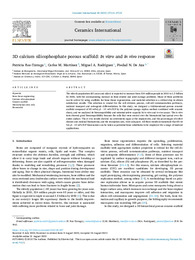Título :
3D calcium silicophosphate porous scaffold: In vitro and in vivo response |
Autor :
Ros-Tarraga, Patricia
Martínez, Carlos M.
Rodríguez, Miguel A.
De Aza, Piedad  |
Editor :
Elsevier |
Departamento:
Departamentos de la UMH::Ciencia de Materiales, Óptica y Tecnología Electrónica |
Fecha de publicación:
2022 |
URI :
https://hdl.handle.net/11000/32397 |
Resumen :
The elderly population (65 years and older) is expected to increase from 524 million people in 2010 to 1.5 billion
by 2050, with the corresponding increase in bone-related and joint damage problems. Many of these problems
can be solved by using scaffolds for bone tissue regeneration, and material selection is a critical step to obtain
satisfactory results. This selection is crucial for the cell division process, cell-cell communication pathways,
nutrient transport and osteogenic differentiation. In this study, we designed a tridimensional porous ceramic
scaffold composed of 85 wt%C2S – 15 wt%TCP by the polymer sponge replica method combined with ceramic
slurry, and we analyzed its biocompatibility and osteoinductive capacity by in vitro and in vivo assays. The in vitro
tests showed good biocompatibility because the cells that were seeded over the biomaterial had spread over the
entire surface. The in vivo results showed no cytotoxicity signs at the implant site, and the percentages of defect
closure and residual biomaterial, and the resorption rate, were adequate. All these results demonstrate that 85 wt
%C2S – 15 wt%TCP bioceramics can be taken as potential bone substitutes to be employed for a range of medical
applications.
|
Palabras clave/Materias:
Bone tissue engineering
Calcium silicophosphate
Ceramic scaffold
Mesenchymal stem cells
Biomaterial |
Área de conocimiento :
CDU: Ciencias aplicadas: Ingeniería. Tecnología |
Tipo de documento :
info:eu-repo/semantics/article |
Derechos de acceso:
info:eu-repo/semantics/openAccess
Attribution-NonCommercial-NoDerivatives 4.0 Internacional |
DOI :
https://doi.org/10.1016/j.ceramint.2022.08.287 |
Publicado en:
Ceramics International 48 (2022) 37114–37121 |
Aparece en las colecciones:
Artículos - Ciencia de los materiales, óptica y tecnología electrónica
|
 La licencia se describe como: Atribución-NonComercial-NoDerivada 4.0 Internacional.
La licencia se describe como: Atribución-NonComercial-NoDerivada 4.0 Internacional.
.png)
